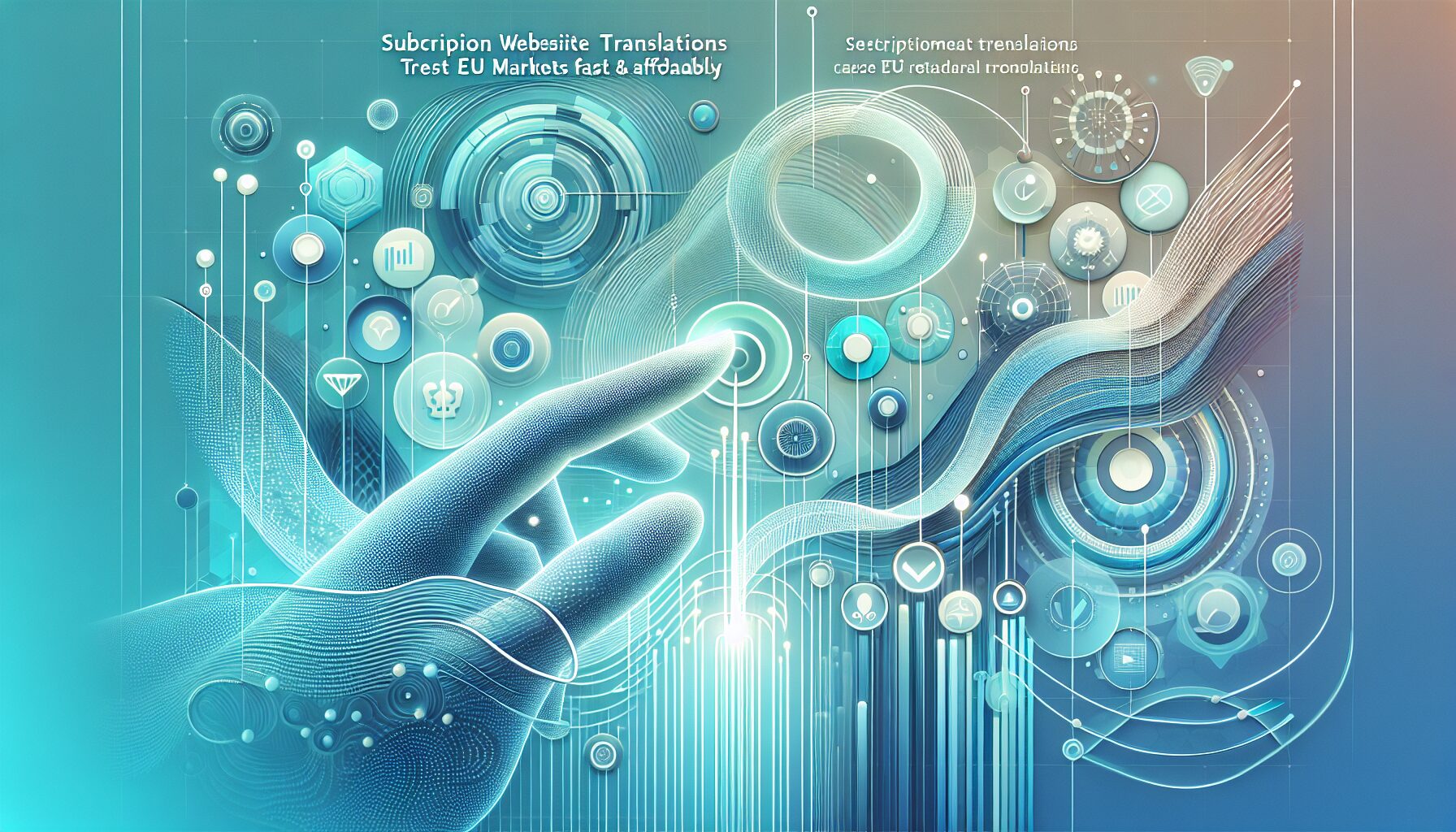About eldris
Clone.Eldris.ai empowers brands to instantly replicate and translate their websites for seamless global expansion. Our automated system delivers SEO-friendly, multilingual clones that launch in days, not months.
In This Article
- Website translation subscriptions are essential for rapid EU market entry.
- They reduce costs, speed up localisation, and support multilingual SEO.
- Platforms offer automation, AI tools, and human editing for consistency.
- Success depends on choosing the right platform for your brand’s needs.
- Continuous optimisation ensures relevance and engagement across regions.
Why EU Market Testing is Crucial for DTC Brands
Understanding growth opportunities across Europe
The European Union presents an expansive and lucrative market for direct-to-consumer (DTC) brands. With over 24 official languages and a diverse consumer base, succeeding in the EU requires careful market testing and intelligent localisation strategies. By evaluating performance and receptivity across various European regions, DTC businesses can determine which territories hold the most potential before committing to full-scale market rollouts.
This is where the value of a strategic website translation subscription becomes immediately apparent. Instead of building separate language sites manually—which can be resource-intensive and time-consuming—DTC brands can use subscription-based translation tools to rapidly launch multilingual versions of their websites, facilitating efficient A/B testing in real-world market conditions. The insight gained can then inform marketing spend, inventory allocation, and customer support capacity.

The Power of Website Translation Subscriptions
Scaling multilingual sites without complexity
Investing in a robust website translation subscription enables brands to scale multilingual capabilities without compromising on quality or agility. These solutions offer ongoing translation services, continuous updates, and automation across product pages, landing pages, FAQs, and meta content. More importantly, many subscription models integrate with modern CMS platforms, reducing the friction of managing content in multiple languages.
A well-executed website translation subscription eliminates the operational burden traditionally associated with localisation. When a new product is launched, or when product copy is updated, the system automatically detects these changes and enacts translations in the selected target languages. This process avoids the delays often experienced in traditional project-based translation workflows.
DTC brands can better allocate their marketing, design, and sales resources by focusing on strategy and customer engagement instead of translation logistics. Furthermore, by coordinating translations through a centralised subscription service, brand messaging remains consistent regardless of language or locale.
Automated Website Cloning & Localisation
Launch quickly in multiple EU languages
One of the most powerful features of a modern website translation subscription is the ability to automate localisation via website cloning. This approach allows brands to instantly duplicate their existing English website into multiple fully translated versions—each tailored to specific EU countries such as Germany, France, or Spain.
In addition to translating the textual content, localisation includes adapting regulatory information, payment methods, shipping policies, and even cultural nuances in design. Subscription platforms that support automation can make real-time adjustments based on defined market parameters, significantly accelerating time to market.
This method also facilitates geo-targeting and personalisation—two essential elements for increasing conversion rates in cross-border commerce. With a clear focus on end-user experience, DTC retailers can present language-specific sites that feel familiar and reliable to local consumers.
SEO Benefits of Multilingual Subscriptions
Unlock organic growth across geographies
Search engine optimisation (SEO) is another critical component improved by leveraging a website translation subscription. Search engines reward relevant and local content, and a translated website with accurate hreflang tags and regional domain structures will perform far better in local search rankings than a generic English version.
When implemented correctly, multilingual SEO strategies drive organic traffic in each target market. Subscription-based tools often include optimisation capabilities such as translating SEO metadata, maintaining URL structure integrity, and automating sitemaps for international indexing. This ensures your content is visible and correctly categorised by Google and other local search engines.
Furthermore, subscription services typically offer built-in quality assurance, including real-time monitoring of translation accuracy, keyword integration, and local search trends. By optimising every layer of your site content—including product descriptions and blog articles—brands can compete effectively in crowded European verticals.
Cost Comparison: Subscriptions vs. Manual Builds
Why automation wins for budget-conscious expansion
Deciding between a subscription-based localisation model or manual builds often comes down to cost-effectiveness versus control. Manual localisation typically involves hiring in-house or freelance translators, coordinating content uploads, and managing localisation project timelines independently. This process can result in inconsistent translation quality and ballooning operational costs.
In contrast, a website translation subscription offers predictable monthly pricing and bundled features such as AI-enhanced pre-translations, post-editing by professional linguists, and platform synchronisation. These features drastically reduce the total cost of ownership compared to piecemeal, manual solutions.
For example, launching five localised EU websites manually might cost tens of thousands upfront, not including future maintenance. Subscription platforms can often deliver comparable or improved results at a fraction of the cost—and within days rather than weeks. For growing DTC brands on tight budgets, the choice is clear.
Choosing the Right Platform for Your Brand
Evaluation criteria for DTC success
Selecting the right website translation subscription platform is critical to your international growth. Key factors to evaluate include language coverage, integration options, translation memory capabilities, customer support, and scalability. Consider platforms that offer content detection, workflow automation, and post-editing features—tools that dramatically boost performance and localisation reliability.
It’s also important to assess whether the platform embraces emerging technologies such as neural machine translation and AI-driven quality assurance. These innovations not only reduce lag time but also enhance linguistic accuracy while preserving the original tone and voice.
Most importantly, ensure the platform aligns with your existing infrastructure. Whether you’re on Shopify, Magento, WordPress, or a headless CMS, compatibility is non-negotiable. A seamless technical integration ultimately supports operational efficiency across marketing, development, and customer experience teams. Learn more about Multilingual website strategies for European expansion
Real-World Successes with Subscription Models
Case studies from scaling eCommerce brands
Leading DTC brands have already reaped the rewards of adopting a website translation subscription for EU expansion. Consider the case of an athleisure brand that used a subscription model to enter five new European markets within three months. They saw a 43% increase in conversion rates in Germany and a 32% decrease in cart abandonment in France—entirely due to better localisation and UX.
Another example is a premium skincare startup that leveraged automated translation workflows to support simultaneous launches in Italy and Spain. By focusing on local SEO and translated copy optimised for skincare search behaviour, they doubled their organic traffic in just under six weeks. Most of these results would not be feasible without a robust subscription framework handling updates and copy synchronisation. Read a related article
Addressing Common Pitfalls in EU Market Launches
Lessons learned from multilingual failures
Despite the advantages of multilingual expansion, several common mistakes continue to derail EU market entries. Chief among them is over-reliance on machine translation without human review. This results in poor localisation, awkward brand voice, and confusing CTAs that undermine visitor trust.
Another mistake is failing to implement standard SEO practices for multilingual sites. Lacking hreflang tags, improper sitemap indexing, and duplicating English content across language folders can cause severe search visibility losses. Additionally, many brands launch without tailoring their payment gateways, shipping rules, or legal disclaimers to local regulations.
A strategic website translation subscription helps mitigate these missteps through built-in compliance frameworks, AI-driven quality checks, and localisation best practices. It’s not merely about translating—it’s about transforming and contextualising your site to succeed regionally. Comparing top translation subscription plans
Comparing Popular Subscription Platforms
Features, pricing, and translation quality
Leading platforms such as Weglot, Lokalise, Transifex, and Phrase offer robust website translation subscription services. Each has its unique position in terms of features, integrations, and pricing models. Weglot shines with instant implementation and eCommerce integrations, while Lokalise offers detailed project management tools for larger enterprises.
When comparing, key considerations include the availability of human-in-the-loop editing, glossary and translation memory support, and dashboard usability. Pricing models can range from flat monthly subscriptions to tiered plans based on word count and languages included. Evaluate whether automated updates, browser language detection, and customer support come as standard, or as add-ons.
Importantly, measure translation quality—some platforms allow for professional post-editing, while others rely entirely on AI. For DTC brands that value brand tone and emotionally resonant messaging, blending machine speed with human precision is essential. AI tools shaping EU e-commerce translation
Future-Proofing Your Localisation Strategy
How AI and automation are shaping the next wave
The future of website translation subscription services lies at the intersection of AI, automation, and brand customisation. Modern platforms are already integrating generative AI to produce initial translations that are remarkably close to human quality. Moreover, real-time localisation updates driven by AI engines can adjust messaging based on seasonal trends or promotional campaigns.
Personalisation across different cultural audiences is also becoming increasingly important. AI will help decipher subtle behavioural cues and refine copy in real time, maximising engagement across EU markets. As data privacy regulations evolve, platforms that handle localisation with built-in compliance will see greater adoption.
To future-proof your international growth, invest in tools that not only meet today’s localisation needs but are also evolving with innovations in natural language processing and automation. Continuous iteration, supported by your website translation subscription, will be key to maintaining a competitive edge in an increasingly connected Europe.
“By switching to a subscription-based localisation service, we expanded into six EU markets in under 60 days—with a 50% lift in revenue from international orders.”
Conclusion: Simple Steps to Expand Across Europe
Adopting a website translation subscription enables DTC brands to scale across Europe with speed, precision, and significantly lower costs than traditional methods. From automated site cloning and multilingual SEO to reducing translation management overhead, the benefits are tangible and immediate.
To begin, evaluate platforms that align with your tech stack, trial their automation and integration features, and pilot multilingual rollouts in key markets. With your subscription in place, continuous optimisation and growth across languages become not only feasible—but frictionless.
Great guide on website-translations-subscription-test-eu-markets – Community Feedback
How can I test multiple EU markets with website translation?
By subscribing to an automated website translation service, you can quickly clone and translate your site into several EU languages, allowing you to test demand and user experience in each market without rebuilding your site.
Are subscription-based localisation tools cost-effective for market expansion?
Yes, subscription-based localisation provides a cost-efficient way to scale fast, avoid large upfront expenses, and adjust your multilingual strategy as your business grows in new EU markets.
Will translated sites be SEO-friendly on these platforms?
Leading subscription platforms produce fully SEO-optimised multilingual sites, including native URLs, hreflang tags, and localised content to improve organic search visibility.










